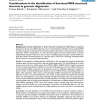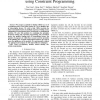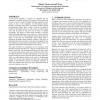758 search results - page 18 / 152 » Coding Exon Detection Using Comparative Sequences |
BMCBI
2004
13 years 9 months ago
2004
Background: In addition to known protein-coding genes, large amounts of apparently non-coding sequence are conserved between the human and mouse genomes. It seems reasonable to as...
BMCBI
2007
13 years 10 months ago
2007
Background: Accurate identification of novel, functional noncoding (nc) RNA features in genome sequence has proven more difficult than for exons. Current algorithms identify and s...
BIBM
2010
IEEE
13 years 7 months ago
2010
IEEE
We propose a method for finding CRMs in a set of co-regulated genes. Each CRM consists of a set of binding sites of transcription factors. We wish to find CRMs involving the same t...
IMSCCS
2006
IEEE
14 years 3 months ago
2006
IEEE
Background: As more and more genomes are sequenced, comparative genomics approaches provide a methodology for identifying conserved regulatory elements that may be involved in gen...
ACMSE
2006
ACM
13 years 11 months ago
2006
ACM
A code clone represents a sequence of statements that are duplicated in multiple locations of a program. Clones often arise in source code as a result of multiple cut/paste operat...




